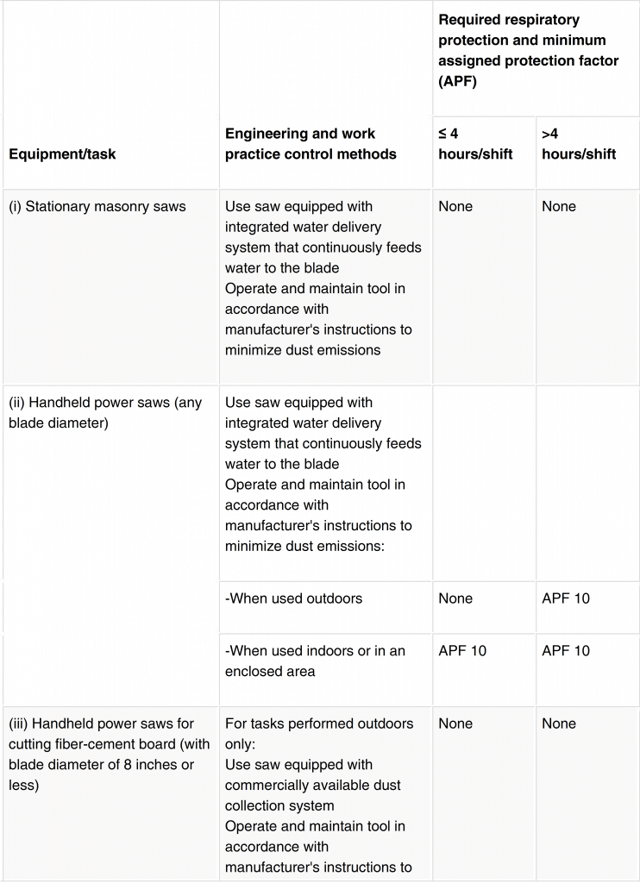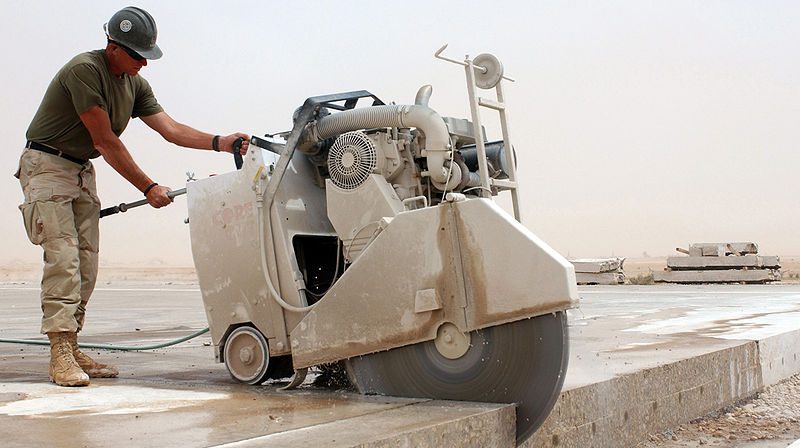By: Kendall Jones on August 7, 2020
5 Tips for Complying With OSHA’s New Silica Dust Rule in Construction
After a three-month delay, OSHA’s Respirable Crystalline Silica in Construction Standard (1926.1153) went into effect on September 23. The delay was so the agency could develop educational and guidance materials regarding the new rules and to provide assistance to companies help them become compliant.
Three days before the new rule was supposed to start being enforced, OSHA released a memo that will delay issuing citations for 30 days, provided that those companies are making a good faith effort to comply with the new rules. Instead, they will be offering assistance to employers to ensure that they are in full compliance. They still have the option to issue citations if they discover an employer is making no effort to comply with the new rules.
Respirable crystalline silica dust is created during work operations like sawing, drilling, grinding and jackhammering involving materials like stone, rock, concrete, brick, block and mortar. Inhalation of crystalline silica dust can lead to bronchitis, silicosis and lung cancer.
The new rule establishes a new standard for the construction industry and reduces the current permissible exposure limit (PEL) of respirable crystalline silica from 250 micrograms per cubic meter of air (μg/m3) averaged over an 8-hour period down to 50 μg/m3.
Here are five tips for making sure you are compliant with OSHA’s new rule:
Follow Table 1
The easiest way to ensure you are adequately protecting your workers from silica dust exposure and complying with OSHA’s new rule is to follow Table 1. Table 1 outlines 18 tasks commonly associated with respirable silica dust exposure. For each task in Table 1 there are engineering controls or work practices to implement to prevent exceeding the permissible exposure limit (PEL) to respirable crystalline silica.
In addition to the engineering controls and work practices, Table 1 also details what, if any, respiratory protection is required. The Assigned Protection Factor (APF) level for respiratory protection that a respirator is expected to meet is determined by the task being performed and the amount of time a worker is performing said task during their shift. There are only a handful of tasks that require respiratory protection if workers are only performing them for four hours or less during a shift.
Most of the control methods in Table 1 involve using tools and equipment with integrated water delivery systems that continuously feeds water to the work surface to keep dust down or to use tools equipped with shrouds and dust collection systems to capture silica dust.
The big benefit from following Table 1 means you won’t be required to establish a scheduled air monitoring program or hunt down objective data to prove that your alternative control methods are reducing workers’ exposure limits below the PEL.

Upgrade Your Tools
If you are planning to use the engineering control methods laid out in Table 1 it might mean you need to upgrade your tools or purchase shrouds and dust collection systems that meet the requirements of Table 1 to be compliant. Dust collection systems must have self-cleaning filters with 99% or greater efficiency. Power tools that require integrated water delivery systems must be capable of continually feeding water to the work surface while the tool is being operated.
The major power tool manufacturers have developed equipment that meets the requirements of Table 1 and can be fitted onto your existing tools. These include shrouds and hollow drill bits that connect to vacuums fitted with self-cleaning HEPA filters. Be sure to let your distributor know that you are looking to comply with the new silica dust rule if purchasing new tools or dust collection systems so they can get you fitted out with what you need.
Provide Training
As with all safety issues, employers need to provide training to workers on the new silica dust rule. Training should cover the health hazards associated with exposure respirable crystalline silica including silicosis, lung cancer, and kidney disease. Workers should be made aware of the tasks on the jobsite that could expose them to silica dust.
Workers should be taught how to use engineering control methods such as dust collection systems and be able to properly attach them to the tools they are working with. Workers should also know which tasks will require the use of respirators and how to use them. Make workers aware of the competent person tasked with implementing the written exposure control plan in case they need clarification on a specific engineering control or work practice.
Employees should also be advised of the medical surveillance obligations required by employers for workers who are required to wear respirators for 30 days or more during a year.
Create a Written Plan
Under the new rule, employers are required to create a written exposure control plan and make it available to all employees. The written plan should contain the following:
- Description of all tasks that involve exposure to respirable crystalline silica
- Details on the engineering control methods, work practices and respiratory protection required for each task to limit exposure
- Housekeeping practices to be used to limit exposure
- Methods used to restrict access to work areas to limit the number employees from being exposed to silica dust
Employers must designate a competent person to ensure that the written plan is being executed properly. The competent person should be making frequent inspections of jobsites, tools, control methods, etc. in accordance with the plan. Written plans should be evaluated at least once a year and updated as needed.
Housekeeping
When cleaning up from work tasks that could produce silica dust it is important that employers limit exposure to workers. Dry sweeping or brushing should be avoided if feasible. Use a HEPA-filtered vacuum or wet sweeping to clean up debris.
Never allow workers to use compressed air to clean off surfaces or clothing unless a proper ventilation system is used to capture the dust.
About Kendall Jones
Kendall Jones is the Editor in Chief at ConstructConnect. He has been writing about the construction industry for years, covering a wide range of topics from safety and technology to industry news and operating insights.

 Sign In
Sign In



